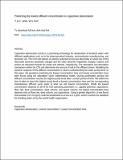| dc.description.abstract | Capacitive deionization (CDI) is a promising technology for desalination of brackish water with different applications such as in the pharmaceutical industry, semiconductor manufacturing, and domestic use. The CDI cell utilizes an electric potential across two electrodes in which one of the electrodes becomes positively charged and the other becomes negatively charged. Cations and anions are attracted towards the anode and cathode, respectively. The adsorption and desorption mechanism within the CDI cell determines the amount of salt in the effluent stream. Modeling the dynamic response of the effluent concentration is vital to understanding the water purity level. In this paper, the equations predicting the lowest concentration time and lowest concentration have been found using the adsorption cycle mathematical model. During purification process the effluent concentration reaches the highest purity level after a certain period of time. We define the time it takes to reach the highest purity level as lowest concentration time and the corresponding instantaneous effluent purer water is what we call lowest concentration. While the lowest concentration depends on all of the CDI operating parameters i.e., applied potential, capacitance, flow rate, feed concentration, dead volume, and spacer volume, the lowest concentration time depends only on flow rate, dead volume, and capacitance. Using a genetic algorithm, it was found that seawater (32,702 ppm) could be desalinated to as low as 2.1 ppm; which is within the standards for drinking water set by the world health organization. | en_US |

